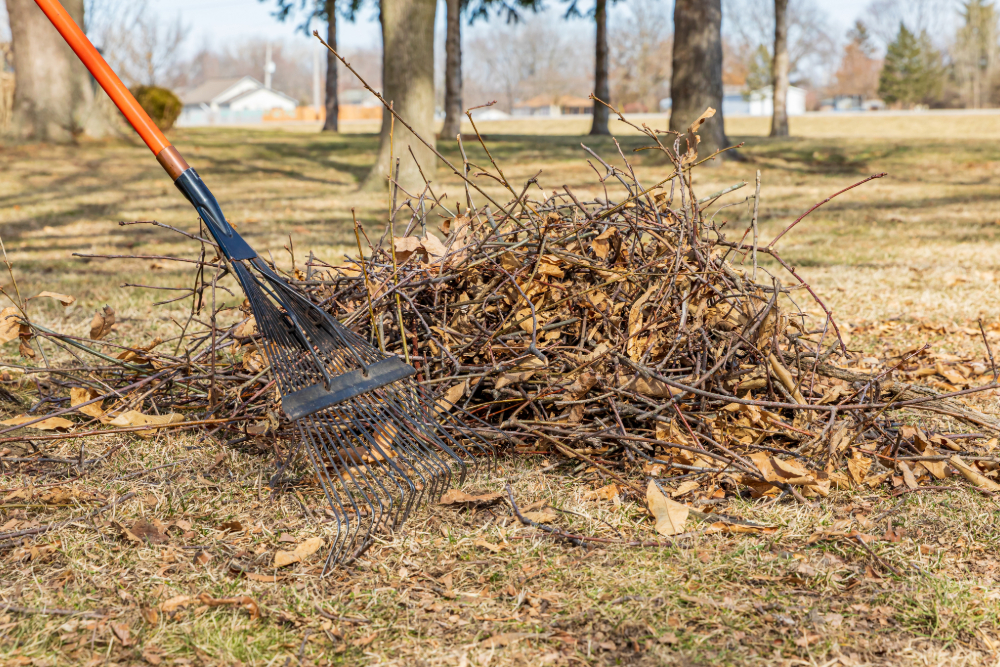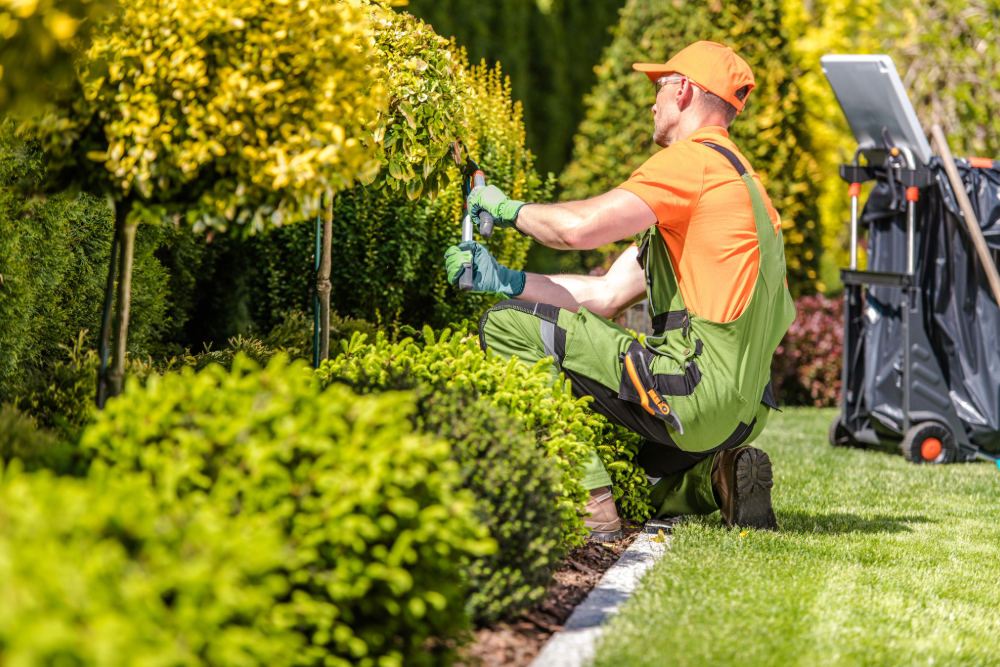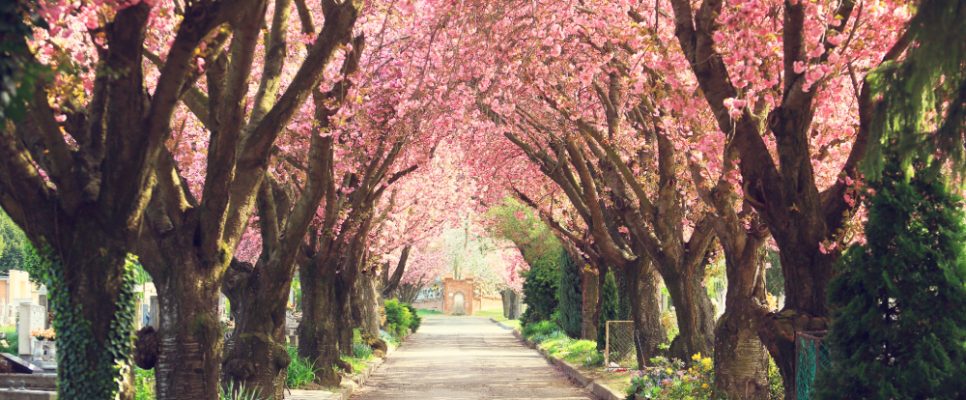Welcome to our seasonal guide to spring maintenance for your commercial landscape! As nature awakens from its winter slumber, it’s time to rejuvenate your outdoor spaces and ensure they flourish throughout the warmer months. With our expert tips, your commercial property will be ready to impress clients, customers, and visitors alike.
Your time is valuable. Maintaining your business’s landscaping can be a lot of work – and at Croy’s Mowing, we’re here to support you every step of the way. So, while you certainly could DIY your landscape maintenance, we’re ready to lend a hand and take care of the busy work while you focus on what you do best – running your business.
Let’s dive into the essential tasks to tackle this spring:

1. Clean Up Winter Debris
The snow has melted, the birds are returning, and it’s time to start Spring cleaning! Before diving into any other landscaping tasks, you always want to start by cleaning up leftover debris from winter. Remove fallen branches, dead foliage, and any other debris that may have accumulated over the colder months. This will not only improve the curb appeal of your landscape, but it will also promote healthier growth.
PRO TIP
Regularly inspect your landscape for debris throughout the winter months, especially after heavy snowfall or windstorms. By staying proactive and promptly removing fallen branches and debris, you can minimize the accumulation of clutter and ensure a smoother cleanup process come springtime.
2. Assess and Repair Hardscape Features
Inspect your hardscape features such as pathways, patios, sidewalks, and retaining walls for any damage caused by frost or snow. Repair cracks, uneven surfaces, and other issues to ensure safety and longevity.
PRO TIP
Nobody likes a trip hazard – it’s a safety concern for both your employees and your customers. It’s a good idea to invest in professional hardscape maintenance services at least once a year to identify and address any potential issues early on. A trained eye can spot signs of damage that may go unnoticed by the untrained observer, helping to prevent costly repairs down the line and prolonging the lifespan of your hardscape features.
3. Soil Preparation and Testing
The ratio of nutrients in your soil changes over time. Your trees, shrubs, and flowers won’t grow well if they can’t get what they need from the soil. It can become costly to replace nutrient-starved plants year after year. A better solution is to maintain the soil. If you have plants that struggled last season, or seem to be struggling now, test your nearby soil’s pH levels and nutrient content to determine its health. Amend the soil as needed with compost, mulch, or fertilizer to provide optimal conditions for plant growth. Proper soil preparation is key to a thriving landscape.
PRO TIP
Consider conducting a more comprehensive soil test every few years to assess nutrient levels, pH balance, and overall health. Armed with this information, you can tailor your soil amendment efforts more effectively, ensuring that your plants receive the nutrients they need to thrive and minimizing the risk of over-fertilization.
4. Prune Shrubs and Trees
Spring is the ideal time to prune shrubs and trees to promote healthy growth and maintain shape. Remove dead or diseased branches and trim back overgrown areas to encourage new growth and improve overall appearance. Pruning is important both for plant health and for landscape safety. As you go, pay special attention to branches that may grow into pathways or droop down over sidewalks. It’s better to address these ahead of time to help avoid potential hazards later in the year.
PRO TIP
Before pruning, disinfect your pruning tools with a solution of one part bleach to nine parts water to prevent the spread of diseases between plants. This simple step can help maintain plant health and reduce the risk of introducing pathogens into open wounds created during the pruning process.
5. Evaluate Irrigation Systems
It’s time to run the sprinklers. Turn them on zone by zone and check your irrigation systems for leaks, clogs, or other issues that may have arisen during the winter. Adjust sprinkler heads and timers to ensure efficient water usage as the weather warms up.
PRO TIP
Nobody likes to see a business watering their lawn in a rainstorm. Install rain sensors or moisture sensors in conjunction with your irrigation system that cano automatically adjust watering schedules based on real-time weather conditions. This smart technology can help prevent overwatering and conserve water by ensuring that irrigation is only applied when necessary.

6. Weed Control and Mulching
Next, apply mulch to flower beds. Mulch offers a multitude of benefits for your landscape. Not only does it suppress weed growth and conserve moisture, but it also helps regulate soil temperature, reduce erosion, and improve soil health by adding organic matter as it decomposes. Additionally, mulch enhances the aesthetic appeal of your landscape, providing a neat and polished look to flower beds and around trees and shrubs.
PRO TIP
Stay ahead of weed growth by implementing a weed control plan early in the season. Apply a layer of organic pre-emergent herbicide before laying down mulch to inhibit weed seed germination. This proactive approach creates an additional barrier against weed growth and reduces the need for manual weeding throughout the season. Be sure to follow product instructions carefully to achieve optimal results while minimizing environmental impact.
7. Plan and Plant
Now is the time to plan and plant new additions to your landscape. We always recommend choosing native plants and flowers that thrive in your region’s climate and conditions. Consider adding pops of color with seasonal blooms to enhance curb appeal – stagger their bloom times to ensure you’ll have beautiful colors during the entire growing season.
PRO TIP
Group plants with similar water and sunlight requirements together to create more efficient irrigation zones and simplify maintenance tasks. By clustering plants according to their needs, you can optimize water usage, minimize resource waste, and create a more cohesive and visually appealing landscape design.

8. Schedule Regular Maintenance
Finally, consider scheduling regular maintenance with Croy’s Mowing to keep your commercial landscape in top condition throughout the season. Our team of experts can handle all aspects of landscape care, allowing you to focus on running your business.
PRO TIP
Not all landscapes are created equal. A once-a-week lawn mowing on its own won’t get you the results you want – and curb appeal matters when you’re running a business. For a top-of-the-line landscape that you and your clients can enjoy all season, establish a proactive maintenance schedule that includes regular inspections and preventative maintenance tasks tailored to the specific needs of your property by a landscaping expert you can trust. By staying ahead of potential issues and addressing them promptly, you can minimize downtime, reduce repair costs, and ensure that your landscape remains in peak condition year-round.
At Croy’s Mowing, we’re committed to helping your commercial property reach its full potential. Contact us today to schedule a consultation and learn more about our comprehensive landscaping services. Together, let’s make this spring a season of growth and beauty for your outdoor spaces!

